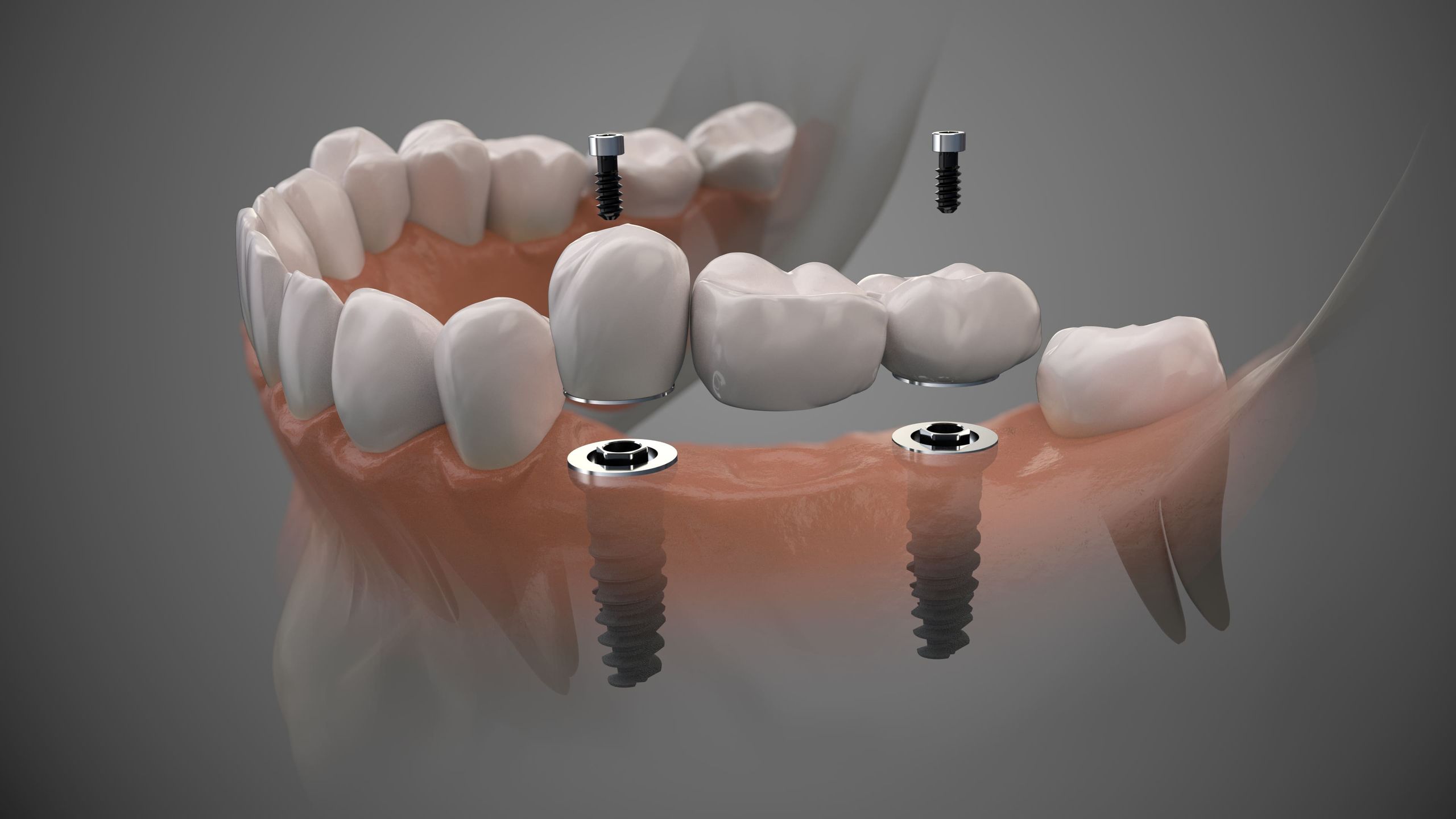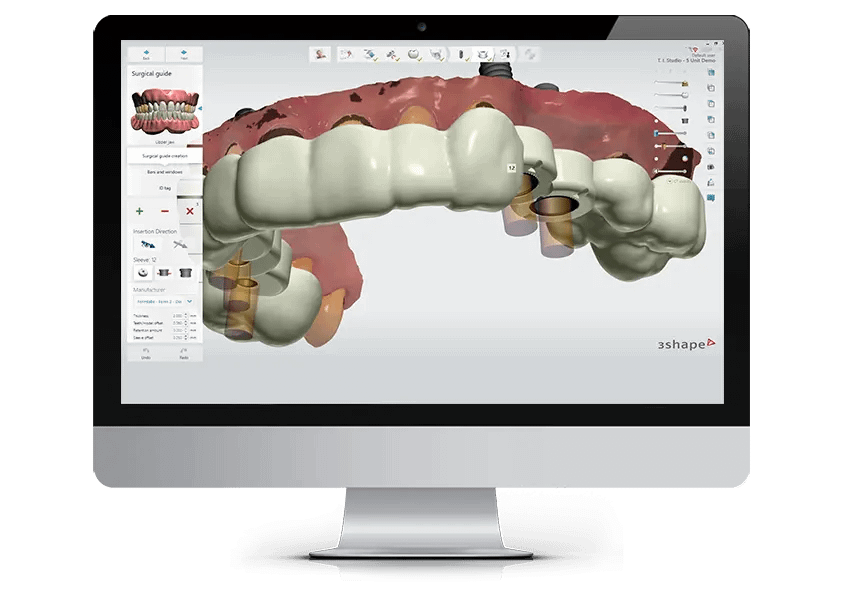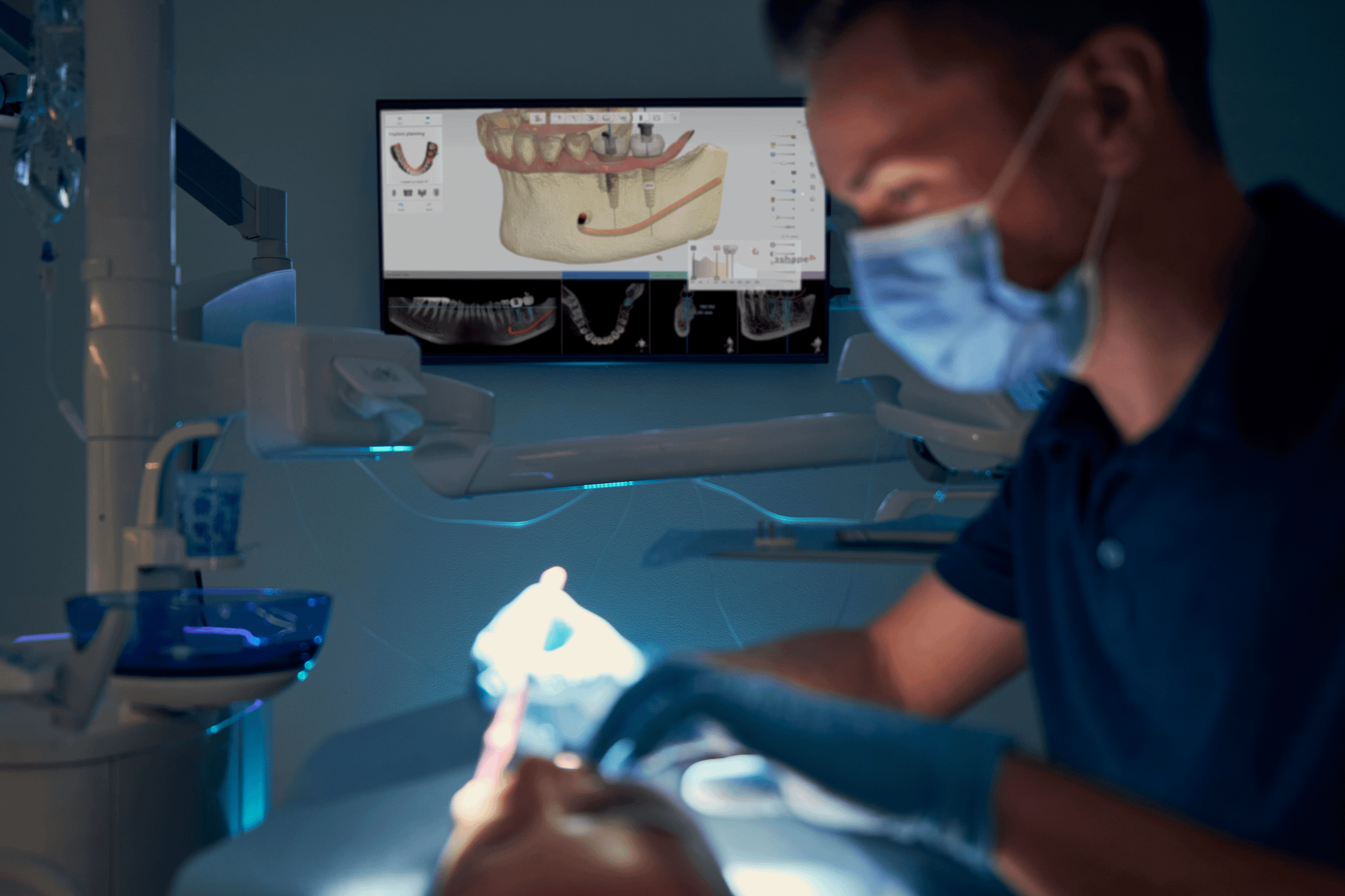- Home
- Blog
- Digital dentistry
- Implant surgical guide — how t...
Implant surgical guide — how to create them with the use of dental software
Of course, dental implant surgery can be done free-hand. It’s how it’s always been done and how some surgeons will keep doing it. However, using a tool in the form of a surgical guide is becoming more and more viable with the maturing of dental implant planning software.
One of the benefits that digital design brings with it, is the possibility to create a quick, very accurate and affordable dental implant surgical guide. This piece, basically an acrylic stent, gives surgeons stable guidance, so that surgery can take place with maximum precision and accuracy. It also enhances patient experience and makes for excellent treatment outcomes.
What is a surgical guide for dental implants?
An implant surgical guide is a piece of acrylic resin that fits right over adjacent teeth, with a hole where the implant is to be placed. It is used when a surgeon needs exact guidance as to where in the bone to drill and prepare for the implant procedure. Because the guide is based on digital impressions or imagery, it is very accurate in indicating the correct position and angle for the dental implant. As for most dental treatments, a digital dental implant treatment plan starts with taking a digital image of the oral cavity, often paired with an X-ray image taken with a dental cone beam CT scanner. In addition, some dentists can use simulation software based on 2D images to help the patient understand treatment outcomes. When all data is merged, the digital implant planning can begin.
Identifying the exact position, shape and size of the implants is done with dental 3D software — in this case implant planning software. Once the plan is finalized and approved by the patient, the dental expert can use the implant plan to render surgical guides for implant placement. In the dental implant surgical guide software, the guide appears on the virtual model and when the doctor is satisfied, they can manufacture it either by 3D printing or by milling (a production process where material is shaped using rotary cutters). Now the doctor has a device in their hand, created on digital precision, that fits right over the teeth and that helps the doctor during surgery. It is the starting point of 3D-guided implant surgery.
Research shows that implant positioning software to help perform guided dental implant placement is especially beneficial in cases with insufficient anatomic orientation and bone height 1. Ramasamy M, Giri, Raja R, Subramonian, Karthik, Narendrakumar R. Implant surgical guides: From the past to the present. J Pharm Bioallied Sci. 2013 Jun;5(Suppl 1):S98-S102. doi: 10.4103/0975-7406.113306. PMID: 23946587; PMCID: PMC3722716..
Usually, the workflow for surgically guided implant placement consists of the following steps:
- Oral cavity scanning and case diagnosing.
- Virtual smile visualization (optional).
- Implant planning.
- Auxiliary guides designing (may differ depending on the surgical guide technique chosen and the specific case).
- Manufacturing (for example 3D printing) of the guides.
- Guided surgery to prepare for dental implant placement.

Types of surgical guides for dental implant placement
Dental implant spacing guides are divided into “static” and “dynamic” 2. Colombo M, Mangano C, Mijiritsky E, Krebs M, Hauschild U, Fortin T. Clinical applications and effectiveness of guided implant surgery: a critical review based on randomized controlled trials. BMC Oral Health. 2017 Dec 13;17(1):150. doi: 10.1186/s12903-017-0441-y. PMID: 29237427; PMCID: PMC5729259.. Static methods are the most widely used now and they make use of a guide that rests on teeth or are fixed on the patient’s teeth, gingiva or bone during the surgery. You can also categorize dental implant 3D guides in:
- Tooth-supported: easily adaptable printed stents, mostly used for single or multiple implants. They can for example be used as a supportive treatment 3. Kim, Taehoon & Jeong, Chang-Mo & Yun, Mi-Jung & Lee, So-Hyoun & Lee, Hyeonjong & Huh, Jung-Bo. (2021). Implant-assisted removable partial denture using digital guide surgery in partially edentulous mandible: A case report. The Journal of Korean Academy of Prosthodontics. 59. 88. 10.4047/jkap.2021.59.1.88. for the creation of digital partial dentures).
- Mucosa-supported guides: can be fabricated based on existing dentures, uses tissue for support, hence there is a risk of inaccuracy.
- Bone-supported guides: used for full-arch edentulous patients, difficult to create and place correctly.
The dynamic technique implies a real-time placement guide to dental implants via the computer navigation system. This technique is used rarely, as it requires extensive experience, but it is very promising because it is digital.

The benefits of dental implant surgical guides
Both dental specialists and patients can benefit from dental implant surgical guide software. Digital workflows in implant dentistry make planning more accurate and precise, and treatment can be done faster and more comfortably. However, there are dentists that are still reluctant to implement digital technologies into their implant practice. They are convinced that free-hand surgery gives a better result, or they experience a barrier for starting with new software and dental technology.
But having tried it, most are convinced that the guided dental implant placement will not undermine their skills but, as this doctor says, will take the mistakes out of my hand during the clinical event.
It will thus not make years of experience obsolete - on the contrary, it will logically complement it 4. Becker CM, Kaiser DA. Surgical guide for dental implant placement. J Prosthet Dent. 2000 Feb;83(2):248-51. doi: 10.1016/s0022-3913(00)80018-9. PMID: 10668038.. Here are some other tangible benefits:
- Higher surgery accuracy. Dental implant sites might be difficult to see or access, because of restricted intra-arch space for example. This means there is always a risk of incorrect placement, which may have negative consequences for the patient and for further treatment. The accuracy of a guided protocol is vital in ensuring the best outcome.
- More comfortable surgery process. Computer-guided dental implant surgery means the doctor can plan the treatment ahead of time, with the prosthetically-driven outcome in mind, as an individual step-by-step process. This means the dentist can work more focused during the actual installation procedures, and performs only the most necessary manipulations. At the same time for the patient this means a less invasive procedure.
- Faster treatment time. Due to the fact that only the most necessary interventions are performed (without unnecessary cuts, for instance), the surgery itself might be faster. Also, due the option to prefabricate components and place them immediately as a provisional restoration, the dentist can reduce the number of appointments needed over the total stretch of treatment time.
- Cost-effectiveness. From a dental clinic point of view, an investment in dental implant treatment planning software will pay off in just a few years, and the increased overall patient satisfaction is priceless. The win for the patient is in the lower amount of appointments needed: a few visits less to the doctor make for cheaper treatment and less anxiety.

Guided implant surgery courses
Resources
- Ramasamy M, Giri, Raja R, Subramonian, Karthik, Narendrakumar R. Implant surgical guides: From the past to the present. J Pharm Bioallied Sci. 2013 Jun;5(Suppl 1):S98-S102. doi: 10.4103/0975-7406.113306. PMID: 23946587; PMCID: PMC3722716.
- Colombo M, Mangano C, Mijiritsky E, Krebs M, Hauschild U, Fortin T. Clinical applications and effectiveness of guided implant surgery: a critical review based on randomized controlled trials. BMC Oral Health. 2017 Dec 13;17(1):150. doi: 10.1186/s12903-017-0441-y. PMID: 29237427; PMCID: PMC5729259.
- Kim, Taehoon & Jeong, Chang-Mo & Yun, Mi-Jung & Lee, So-Hyoun & Lee, Hyeonjong & Huh, Jung-Bo. (2021). Implant-assisted removable partial denture using digital guide surgery in partially edentulous mandible: A case report. The Journal of Korean Academy of Prosthodontics. 59. 88. 10.4047/jkap.2021.59.1.88.
- Becker CM, Kaiser DA. Surgical guide for dental implant placement. J Prosthet Dent. 2000 Feb;83(2):248-51. doi: 10.1016/s0022-3913(00)80018-9. PMID: 10668038.